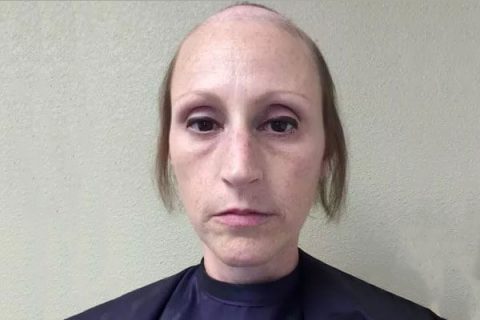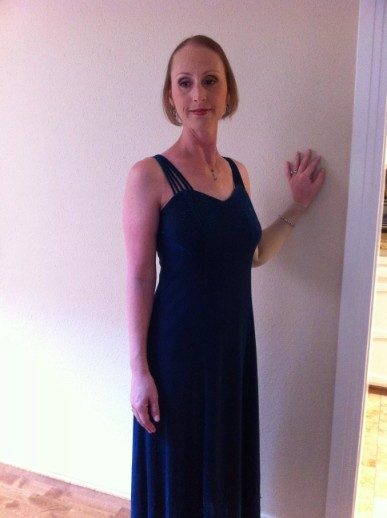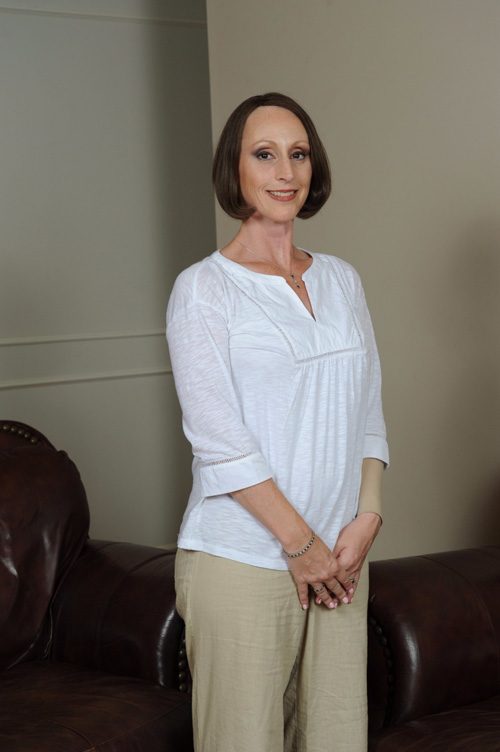
Breast Cancer Survivor who took Taxotere: ‘I Should Not be Permanently Disfigured’
For more than 1,600 breast cancer survivors who received the chemotherapy drug Taxotere, permanent baldness, known as alopecia, is a constant, unwanted reminder of the illness they fought so hard against. It’s the reason that even after five years in remission, they are treated as “sick people” by strangers. It’s why they do not appear in pictures for years at a time, and it’s the reason they have to answer questions from their children about why other women get their hair back but their mom didn’t.
Women who receive Taxotere to treat their breast cancer expect their hair to fall out — they prepare themselves for it. What they may not know to prepare for is never getting their hair back.
“I should not be permanently disfigured,” said Ami Dodson, a breast cancer survivor living with chemo-induced alopecia. “I get told this all the time, ‘Well, you’re not dead. Shouldn’t you just be grateful the chemo saved your life?’ No, I should be alive and also have hair. Disfigurement is not something we should accept as something that’s par for the course.”
Dodson, now in her 40s, was diagnosed with a very aggressive, fast-growing tumor in 2010 at age 35. Doctors used the chemotherapy drug Taxotere to treat her cancer. Dodson was later diagnosed with permanent chemo-induced alopecia. There is currently no known cure.
Taxotere is used to treat the majority of breast cancer cases in the U.S., but it is not the only drug of its type available. Patients may choose Taxotere because treatment with the drug is once every three weeks — unlike the similar drug Taxol (paclitaxel), which may be given weekly.
What many women don’t know is that Taxotere has a higher rate of permanent hair loss than similar drugs on the market. Breast cancer survivors who were treated with Taxotere say they were never properly warned of the risk and could not make an informed choice. Had they known about Taxotere’s link to permanent hair loss, the women say they would have opted for another treatment.
“People need to be empowered with knowledge to make the choices that are best for them, their health and their entire wellbeing.”
“Taxotere did this to me. It was not chemo. It was Taxotere,” Dodson said. “I could have lived and also not have this debilitating disfigurement that has just destroyed my life. That was a possibility. I didn’t know it then, but I know it now.”
Two Bouts with Cancer by Age 35
Breast cancer was actually Dodson’s second major cancer. When she was 20 years old, she had Hodgkin lymphoma, which doctors treated primarily with radiation.
From the time she was 20, she was advised that there was a strong correlation between Hodgkin lymphoma and breast cancer, and that coupled with the radiation to her chest put her in a high-risk category for breast cancer.

Doctors told Dodson she should start getting mammogram screenings at age 35 as opposed to age 40. (The conventional wisdom at the time was women could wait until they turned 40 for their first screening.)
In 2010, Dodson turned 35 and decided that 36 would be as good as 35, and that there was no harm in waiting a year. She told herself she wasn’t going to get a mammogram.
“I just didn’t want to,” Dodson said. “It was my husband who brought me kicking and screaming to the mammogram. He told me later that he had actually felt a lump but didn’t want to frighten me.”
Dodson had one mammogram, followed by an ultrasound and a biopsy.
“Sure enough that was it — I had breast cancer,” Dodson said. “If not for my husband, I would not have survived. By 36, I would have been dead.”
Dodson quickly learned that she tested positive for the BRCA 2 genetic mutation, which meant an additional increased risk for ovarian cancer.
At the time of her breast cancer diagnosis, Dodson’s son was 5 and her daughter was 2. Dodson was hoping to have a third pregnancy that year. Her oncologist strongly advised against it.
“Because I am BRCA 2 positive, I needed my ovaries removed, and because I had a hormone-positive tumor — so estrogen-receptor positive, progesterone-receptor positive, ER/PR+, HER2-— if I had gotten pregnant as planned, it’s like giving steroids to your tumor — not a good idea.”
Dodson said she was not as surprised by the breast cancer diagnosis as she thinks a lot of other women might be because she had already had cancer once.
“The Hodgkin lymphoma was a major speed bump and was difficult, but it didn’t derail my life in the same way that the breast cancer did, so I was kind of thinking, ‘Oh gosh — here we go again. This is going to be terrible, but a year from now I’ll be past this,’” Dodson said. “It very much turned out that is not the case.”
Treating Breast Cancer with Taxotere
Dodson went through an enormous amount of radiation from her chin to her belly button to treat the Hodgkin lymphoma in 1995. So, when she was considering treatment options for her breast cancer 15 years later, she knew radiation was off the table.
“I met with a radiation oncologist at the time,” Dodson said. “I spoke to him and he said, ‘You should already glow in the dark. You can’t possibly get one more bit of radiation.’”
Dodson had a 1.8-centimeter tumor in her left breast, plus microscopic disease in two axillary lymph nodes. Her doctor recommended a mastectomy first, followed by six rounds of the chemotherapy drugs Taxotere and Cytoxan.
After her first infusion of chemo but before her second, Dodson still had all her hair and was hopeful she would not lose it.
“I had just started to think, ‘Hmmm. Maybe I’m going to be that one in a million special snowflake whose hair does not fall out,’” she said. “I had heard stories of that happening but never met anyone for whom that happened.”
But with just a week to go until her second treatment, Dodson was brushing her hair and realized it was falling out.
“It’s hard to describe. You brush your hair and some hair always comes off but this is different. It just kind of detached from my head.”
She said she was scared and in disbelief.
The cancer “didn’t seem real and then my hair started falling out in clumps,” Dodson said. “It made it very, very intense. I was curled up on the floor of my bedroom, sobbing and talking on the phone to my friend. It was a moment I will never forget.”
Chemo-Induced Permanent Hair Loss
Dodson went through a day or two of her hair falling out, and then her husband helped her shave her head.
“Before chemo, I got a super-cute short haircut, so that I would have something to look forward to when it was growing back,” Dodson said. “That was the idea — you get a pre-chemo cut, so you could see what your hair would look like. Ironically, I never had that short cute haircut again.”
For about five years, Dodson waited for her hair to grow back. Doctor after doctor told her to be patient and that everyone’s hair grows back at different rates.
“I finally realized this is not slow growth,” Dodson said. “This is your hair follicles are dead and they’re not coming back. Then my oncologist gave me a diagnosis of permanent chemo-induced alopecia.”
What angers Dodson the most about her situation is that it was avoidable.
“I am so angry — mostly because this didn’t have to be my outcome,” Dodson said. “I was given Taxotere and Cytoxan, but I could’ve had Taxol, which is a similar drug in the same family of drugs but the incidence of permanent alopecia with Taxol is virtually nonexistent. If I had had any inkling that this was going to happen to me, there is no doubt I would’ve opted for Taxol.”
Living with Alopecia
During treatment and for about a year afterward, Dodson wore long, flowy scarves to hide her baldness. She experimented with wigs, but didn’t care for them. About a year after treatment, she stopped wearing head coverings because she thought her hair was going to come back. She refused to let anyone take her picture during that time.
“There are lots of pictures of my kids,” she said. “There are lots of pictures of my family doing typical family stuff, but I’m not in them. I have very few pictures of me with them for a period of five years. It’s heartbreaking.”

When Dodson realized her hair was not going to grow back, she started wearing wigs every day. This was in part because she was constantly being treated like a sick person, she said.
“Five years after I finished my last round of chemo, people would stop me on the streets and say, ‘My sister also has breast cancer and good for you. Keep up the fight,’” she said. “They were really well-meaning, but I thought, ‘I am not actually sick. I am in remission. I’ve been in remission for five years.’”
Dodson’s daily struggles with alopecia are not limited to interactions with strangers. She has had several conversations about it with her children, who are now ages 9 and 12.
“Just recently, my daughter asked me why my hair didn’t grow back but other people’s do,” Dodson said. “I think she was under the impression that every time someone goes through chemo their hair falls out and they never get it back. I had to explain that for most people their hair does grow back. Just not me.”
Dodson wears what is known as a bonded topper: a wig that is specifically created to fit her head, and then attached using surgical-grade adhesive. Every other week, Dodson goes to a specialty clinic where trained professionals take the wig off, clean her scalp, wash everything and reattach the hair unit. The bond holds for about two weeks, and every four months the entire unit needs to be replaced. Because of the special nature of the wig and the extensive maintenance it requires, the costs are high.
“Just being able to get out of bed in the morning and go about my normal life requires a lot of time and expense,” Dodson said. “But it’s what I have to do to look normal.”
Permanent hair loss has dominated Dodson’s life — and it still does, she said.
“It put a lot of strain on my marriage,” Dodson said. “It still is rough. It has had a traumatic toll on my relationship with my husband, my self-image, my self-esteem, and it has been hard on my kids, too.”
Taxotere Lawsuit: ‘I Was Not Warned’
Dodson is one of more than a thousand women who have sued Sanofi over allegations that the company failed to adequately warn breast cancer patients that Taxotere causes permanent hair loss.
“I meet women all the time who are suffering varying degrees of hair loss from Taxotere, and some of them have heard about the lawsuit — a lot of them haven’t,” Dodson said. “There are thousands more who just haven’t realized. It took me five years to realize this was permanent and no amount of specialty shampoo was going to help. There are a lot of women who have been harmed.”
More than 1,600 Taxotere lawsuits are pending in the Eastern District of Louisiana under what is known as a multidistrict litigation, or MDL. Four of those cases are expected to go to trial in 2019.
Lawsuits say Sanofi-Aventis sold Taxotere without properly testing it, failed to determine whether the drug was safe and manufactured a dangerous drug. Plaintiffs also allege the company misled the public in advertising and marketing, downplayed the dangers associated with the drug and kept information from the public.
“I have a piece of paper where I jotted down notes when I was talking to my oncologist in 2010 about the various side effects of the different chemos he was suggesting to me, and I wrote down Taxotere: short-term hair loss,” Dodson said. “I wrote down all kinds of very specific details and nowhere on that page does it mention possible permanent hair loss. I was not warned.”
Perhaps the chief allegation is that Sanofi sold Taxotere without properly disclosing the dangers or risks to patients or health care professionals.
‘Ask All the Questions’
Dodson serves on the board of directors for Bay Area Young Survivors, a support and action group for young women in the San Francisco Bay Area who are living with breast cancer.
- Ask all the questions
- Educate themselves
- Get the most up-to-date information
- Make sure they are 100 percent comfortable with the treatment plan they are choosing
- Get a second opinion
- Choose a doctor they trust and who knows all the risks
When deciding on a treatment plan, women should think long-term, Dodson said.
“Think about your whole life,” she said. “I wanted to be done so badly. I just wanted to get through it. I wanted it to be over. It didn’t occur to me that it would never be over. It’s never over.”
Calling this number connects you with a Drugwatch.com representative. We will direct you to one of our trusted legal partners for a free case review.
Drugwatch.com's trusted legal partners support the organization's mission to keep people safe from dangerous drugs and medical devices. For more information, visit our partners page.


